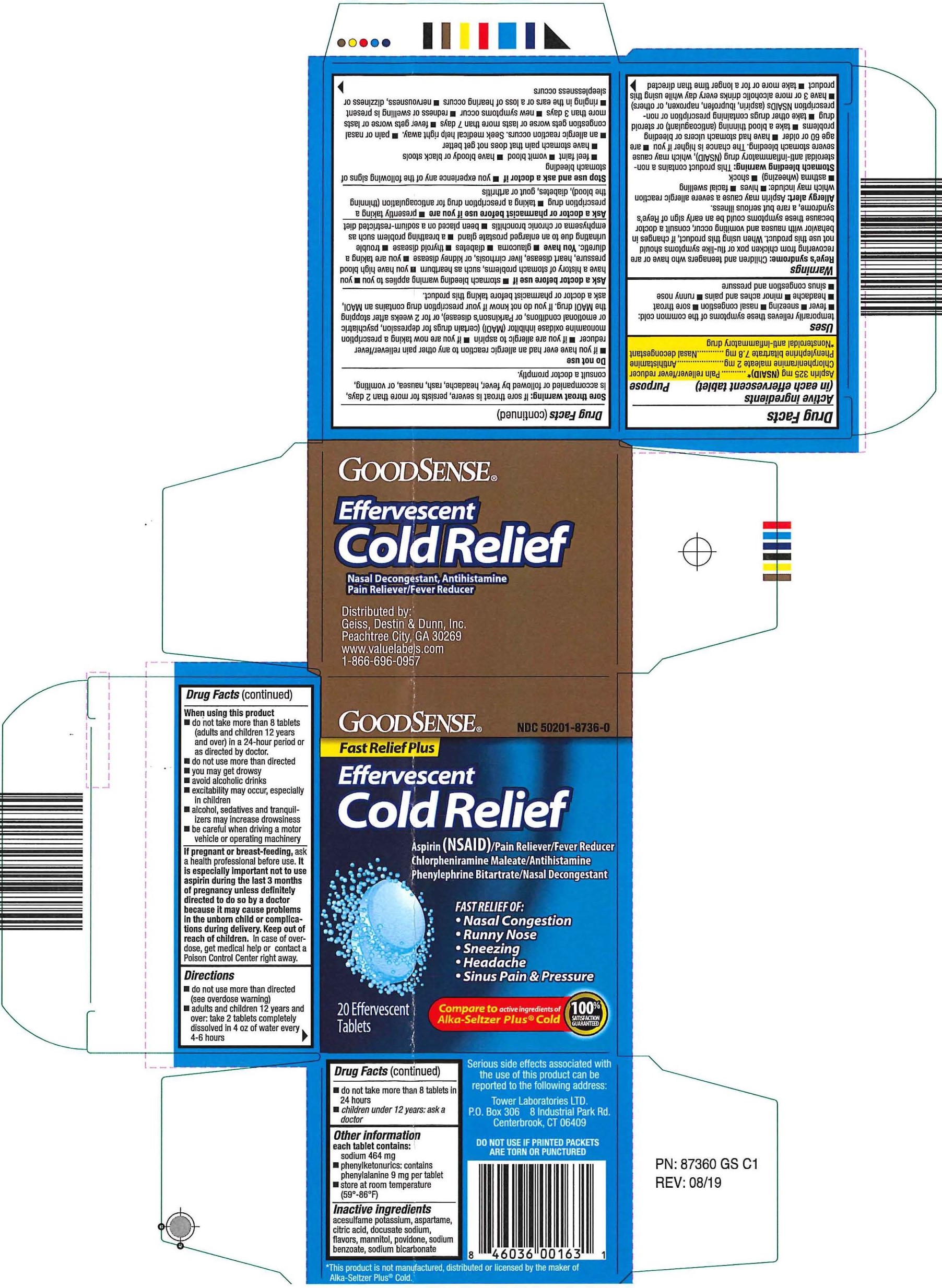Good Sense Effervescent Cold Relief while Breastfeeding

What is Good Sense Effervescent Cold Relief used for?
Brief: Pain reliever/fever reducer Antihistamine Nasal decongestant
Good Sense Effervescent Cold Relief while breastfeeding safe or not? Can there be any side effects for infant while using it during breastfeeding?

Good Sense Effervescent Cold Relief Breastfeeding Analsys
Chlorpheniramine maleate while Breastfeeding
Low RiskCAS Number: 132-22-9
First generation antihistaminic and alchylamine drug, with sedative effect. Its active isomer is Dexchlorfeniramine. Likely inhibition of lactation within the first weeks post delivery because anti-prolactin effect.. Short-term and low dose (2 mg one or twice-day) treatment is compatible with breastfeeding. Be aware of somnolence in the child. For long-term treatment an alternative drug should be preferred. Compounds in association with expectorants, corticoids and cough relief medicines are available. Avoid drug associations especially while breastfeeding. Follow-up for sedation and feeding ability of the infant. Bed-sharing is not recommended for mothers who are taking this medication.
Phenylephrine bitartrate while Breastfeeding
Low RiskCAS Number: 59-42-7
Used on topical decongestant solutions for nose drops at low concentration. 10% midriatic eye drops are available. Because low concentration is used on nose and ophtalmic drops a significant excretion into breast milk is unlikely. Low oral biodisponibility minimizes any risk of harmful effect in the infant. Authorized for nasal or ophtalmic use on children aged younger than 1 year. Although on latest update relevant data on breastfeeding was not found it is considered to be safe when minimal dose is used. Avoid excessive or long term use. A related drug Pseudoephedrine can inhibit milk production. It would be advisable to press on the lachrimal sac to minimize absorption.
Aspirin while Breastfeeding
Low RiskCAS Number: 50-78-2
Excreted in non-significant amount into breast milk. Reye’s Syndrome has never been reported due to ASA through breast milk. It is thought to be highly unlikely to occur after isolated or small doses like those used for treatment of thrombosis or anti-abortion therapy. At high maternal dose, one case (dubious) of salicylic intoxication in the neonatal period and another case of thrombocytopenia in an infant have been reported. Likelihood of hemolysis should be considered in those patients with G6PD-deficiency. WHO Model List of Essential Medication: compatible while breastfeeding when used occasionally or small dose for antithrombotic prophylaxis management.
Good Sense Effervescent Cold Relief Breastfeeding Analsys - 2
Chlorpheniramine maleate while Breastfeeding
CAS Number: 132-22-9
Small (2 to 4 mg), occasional doses of chlorpheniramine are acceptable during breastfeeding. Larger doses or more prolonged use might cause effects in the infant or decrease the milk supply, particularly in combination with a sympathomimetic such as spseudoephedrine or before lactation is well established. Single bedtime doses after the last feeding of the day may be adequate for many women and will minimize any effects of the drug. The nonsedating antihistamines are preferred alternatives, though.
Phenylephrine bitartrate while Breastfeeding
CAS Number: 59-42-7
The oral bioavailability of phenylephrine is only about 40%,[1] so the drug is unlikely to reach the infant in large amounts. However, intravenous or oral administration of phenylephrine might decrease milk production. Because no information is available on the use of oral phenylephrine during breastfeeding, an alternate drug may be preferred, especially while nursing a newborn or preterm infant.Phenylephrine nasal spray or ophthalmic drops are less likely to decrease lactation. To substantially diminish the effect of the drug after using eye drops, place pressure over the tear duct by the corner of the eye for 1 minute or more, then remove the excess solution with an absorbent tissue.
Aspirin while Breastfeeding
CAS Number: 50-78-2
After aspirin ingestion, salicylic acid is excreted into breastmilk, with higher doses resulting in disproportionately higher milk levels. Long-term, high-dose maternal aspirin ingestion probably caused metabolic acidosis in one breastfed infant. Reye's syndrome is associated with aspirin administration to infants with viral infections, but the risk of Reye's syndrome from salicylate in breastmilk is unknown. An alternate drug is preferred over continuous high-dose, aspirin therapy. After daily low-dose aspiring (75 to 325 mg daily), no aspirin is excreted into breastmilk and salicylate levels are low. Daily low-dose aspirin therapy may be considered as an antiplatelet drug for use in breastfeeding women.[1][2][3].
What if I already have used Good Sense Effervescent Cold Relief?
During whole lactation period you shall first discuss with your doctor and then together you shall decide whether you shall take that drug or not however if you have already taken Good Sense Effervescent Cold Relief then you shall inform your doctor, But you should not be worried too much as Good Sense Effervescent Cold Relief comes in category of low risk drug.
I am nursing mother and my doctor has suggested me to use Good Sense Effervescent Cold Relief, is it safe?
Though Good Sense Effervescent Cold Relief dose not comes in category of safe drugs rather it comes in category of low risk but if your doctor is aware that you are breastfeeding your baby and has still recommended it then its advantages must be outweighing the risks.
If I am using Good Sense Effervescent Cold Relief, will my baby need extra monitoring?
Not much
Who can I talk to if I have questions about usage of Good Sense Effervescent Cold Relief in breastfeeding?
US
National Womens Health and Breastfeeding Helpline: 800-994-9662 (TDD 888-220-5446) 9 a.m. and 6 p.m. ET, Monday through Friday
UK
National Breastfeeding Helpline: 0300-100-0212 9.30am to 9.30pm, daily
Association of Breastfeeding Mothers: 0300-330-5453
La Leche League: 0345-120-2918
The Breastfeeding Network supporter line in Bengali and Sylheti: 0300-456-2421
National Childbirth Trust (NCT): 0300-330-0700
Australia
National Breastfeeding Helpline: 1800-686-268 24 hours a day, 7 days a week
Canada
Telehealth Ontario for breastfeeding: 1-866-797-0000 24 hours a day, 7 days a week
